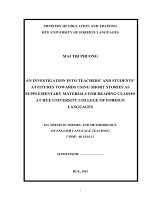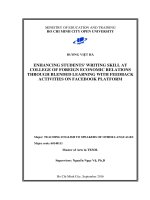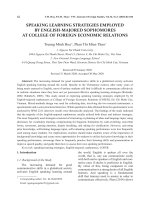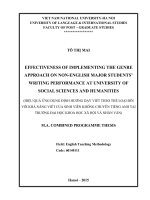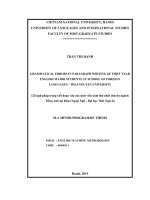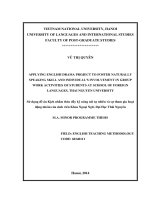Enhancing students writing skill at college of foreign economic relations through blended learning with feedback activitives on facebook platform a thesis submitted in partial fulfillment
Bạn đang xem bản rút gọn của tài liệu. Xem và tải ngay bản đầy đủ của tài liệu tại đây (2.33 MB, 136 trang )
MINISTRY OF EDUCATION AND TRAINING
HO CHI MINH CITY OPEN UNIVERSITY
DƢƠNG VIỆT HÀ
ENHANCING STUDENTS' WRITING SKILL AT
COLLEGE OF FOREIGN ECONOMIC RELATIONS
THROUGH BLENDED LEARNING WITH FEEDBACK
ACTIVITIES ON FACEBOOK PLATFORM
Major: TEACHING ENGLISH TO SPEAKERS OF OTHER LANGUAGES
Major code: 60140111
Master of Arts in TESOL
Supervisor: Nguyễn Ngọc Vũ, Ph.D
Ho Chi Minh City, September 2016
STATEMENT OF AUTHORSHIP
I certify that this thesis entitled “Enhancing students' writing skill at College of
Foreign Economic Relations through blended learning with feedback activities on
Facebook platform” is my own work.
Except where reference is made in the text of the thesis, this thesis contain material
published elsewhere or extracted in whole or in part from a thesis by which I have
qualified for or been awarded another degree or diploma.
No other person‟ work has been used without due acknowledgement in the main
text of the thesis.
This thesis has not been submitted for the award of any degree or diploma in other
tertiary institution.
Ho Chi Minh City, 2016
Dương Việt Hà
i
ACKNOWLEDGEMENTS
I would like to express my deepest gratitude to my supervisor, Dr. Nguyễn Ngọc
Vũ, who gave love, care, invaluable support, suggestions, and encouragement in all
stages of doing this research. Without his critical comments and great contribution,
this thesis would not have been completed. I am so grateful that I had a chance to
carry out the thesis under his supervision.
Immeasurable appreciation and the deepest gratitude for the help and support are
extended to the following persons who are in one way or another way have
contributed to making this thesis possible:
All the lecturers at the Post graduate Faculty, for their great helps with
benificial knowledge and experience in teaching and in the process of conducting a
research paper.
Dr. Pham Vu Phi Ho, lecturer and co-ordinator of MA program in TESOL at
Ho Chi Minh City Open University, for his dedication to conferences and minipresentation for TESOLers to present our works, to giving profound instructions,
and providing helps when necessary.
Dr. Pham Chau Thanh, Headmaster of COFER, all the teachers in the
Department of Foreign Languages and colleagues, for their great contribution and
cooperation in the process of the study.
All the members of TESOL7, great friends for their materials and spiritual
support.
All the students participated in the study, for their enthusiastic contribution
and cooperation.
In addition, a great thank to my parents, my wife and my children for always being
with me. Without their support and sacrifice, I would not have a chance to finish the
thesis.
ii
Abstract
The current study explores whether the blended learning with feedback
activities on a social networking website called Facebook enhances the students‟
writing skill. It also investigates the aspects of feedback students received on their
writing and examines their attitudes towards the use of Facebook for feedback. The
study involves 40 college students who were divided into control group and
experimental group. The experimental group experienced the activity of posting
their writing on Facebook platform in order to give and receive feedback with an
aim of developing their writing skill over the English academic writing-1 course.
Data were collected from the original writing as pre-test and the revised writing
after feedback activities as post-test, the results of peer e-feedback using a common
feedback format provided, a questionnaire and an interview. While the pre-test and
post-test analysis was the main data collection method, a questionnaire and an
interview provided supplementary and crucial information. The results revealed that
there is a significant difference in pre-test and post-test score. The aspect of
students‟ feedback focused mainly on topic sentence and concluding sentence,
sentence structure, grammar and spelling (language form) more than organization
and body of the paragraph. Finally, the analysis of questionnaire and interviews
showed that the students have positive attitudes towards the use of Facebook for
feedback activity in the English Academic writing class because of its convenient
feature.
iii
TABLE OF CONTENTS
Statement of authorship................................................................................................ i
Acknowledgements .....................................................................................................ii
Abstracts .................................................................................................................... iii
Table of contents ........................................................................................................ iv
List of tables ..............................................................................................................vii
List of figures .......................................................................................................... viii
List of abbreviations ................................................................................................... ix
Chapter 1: INTRODUCTION
1.1 Background of the study ....................................................................................... 1
1.2 Statement of the Problem ..................................................................................... 2
1.3 Purpose of the Study ............................................................................................. 3
1.4 Research Questions............................................................................................... 3
1.5 The significance of the Study ............................................................................... 3
1.6 Organization of the Study ..................................................................................... 4
Chapter 2: LITERATURE REVIEW
2.1 Theories of Second Language Learning ................................................................ 6
2.1.1 Social Cognitive Learning Theory .......................................................... 6
2.1.2 Social-cultural Learning Theory ............................................................. 7
2.1.3 Writing Process Approach Theory.......................................................... 9
2.2 Writing Skill and Teaching Writing .................................................................... 10
2.2.1 Writing Skill .......................................................................................... 10
2.2.2 Teaching Writing................................................................................... 12
2.3 Stages of writing process approach of the current study .................................... 13
2.4 Blended learning ................................................................................................. 14
2.5 Feedback ............................................................................................................. 16
2.5.1 Feedback ............................................................................................... 16
iv
2.5.2 Peer Feedback ....................................................................................... 17
2.5.3 Advantages of Peer Feedback ............................................................... 18
2.5.4 Disadvantages of Peer feedback ........................................................... 20
2.5.5 E-feedback ............................................................................................ 21
2.6 Social Networking Service and Facebook .......................................................... 22
2.7 Group in Facebook for English Teaching and Learning ..................................... 25
2.8 Review of Related Studies .................................................................................. 26
Chapter 3: METHODOLOGY
3.1 Pedagogical context ............................................................................................ 36
3.1.1 Pedagogical setting ................................................................................ 36
3.1.2 Course Description ................................................................................ 36
3.1.3 Participants ............................................................................................ 38
3.2 Design of the Study ............................................................................................. 46
3.3 Procedures of the Study ...................................................................................... 47
3.3.1 Preparation for feedback activities on Facebook platform ................... 47
3.3.1.1 The Role of experimental group participants .......................... 47
3.3.1.2 The Role of Instructor ............................................................. 48
3.3.1.3 The Role of Facebook platform .............................................. 48
3.3.2 Training Process .................................................................................... 49
3.3.3 Learning activities of the participants ................................................... 50
3.4 Research Instruments .......................................................................................... 53
3.4.1 Questionnaires ....................................................................................... 53
v
3.4.2 Interviews .............................................................................................. 56
3.4.3 Scoring Rubric....................................................................................... 57
3.4.4 Validity and Reliability of the Questionnaires ...................................... 58
3.5 Methods of Analysis ........................................................................................... 63
3.5.1 Criteria to analyze the questionnaire ..................................................... 64
3.5.2 Criteria to analyze pre-test and post-test results ................................... 64
3.5.3 Data Analysis for Research Questions .................................................. 65
3.6 Ethical conditions ................................................................................................ 68
Chapter 4: FINDINGS AND DISCUSSION
4.1 Before the treatment ............................................................................................ 69
4.2 After the treatment .............................................................................................. 73
4.2.1 Research Question 1............................................................................ 73
4.2.2 Research Question 2............................................................................ 75
4.2.3 Research Question 3............................................................................ 82
Chapter 5: IMPLICATION AND RECOMMENDATION ...................................... 87
5.1 Implication ............................................................................................. 88
5.2 Limitations of the study ......................................................................... 88
5.3 Recommendation ................................................................................... 89
References
Appendices
vi
LIST OF TABLES
Table 3.1 Participants‟ gender
38
Table 3.2 Learners having the Internet access at home
41
Table 3.3 Devices for accessing Facebook
44
Table 3.4 Design of the Study
46
Table 3.5 Summary of pre-training questionnaire information
55
Table 3.6 Summary of post-training questionnaire information
56
Table 3.7-a: The Reliability Statistics of first part of pre-training questionnaire
60
Table 3.7-b: The Reliability Statistics of second theme of pre-training
questionnaire
61
Table 3.7-c: the Reliability Statistics of third theme of pre-training questionnaire 61
Table 3.7-d: the Reliability Statistics of fourth theme of pre-training
questionnaire
62
Table 3.8-a: the Reliability Statistics of first theme of post-training questionnaire 62
Table 3.8-b: the Reliability Statistics of second theme of post-training
questionnaire
63
Table 4.1 Independent Sample Test of first part of pre-training questionnaire
69
Table 4.2 T-test for Equality of Means for second main part of pre-training
questionnaire
70
Table 4.3 T-test for Equality of Means for third main part of pre-training
questionnaire
71
Table 4.4 T-test for Equality of Means for fourth main part of pre-training
questionnaire
71
Table 4.5 The comparison of pre-test writing scores
72
Table 4.6 The comparison of pre-test and post-test results
74
Table 4.7 Results for Post-training Questionnaire
76
Table 4.8 Statistics of the learners‟ feedback on topic and concluding sentence
84
Table 4.9 Statistics of the learners‟ feedback on Body with supporting Sentences 84
Table 4.10 Statistics of the learners‟ feedback on sentence structure
vii
84
Table 4.11 Statistics of the learners‟ feedback on Grammar and Spelling
85
Table 4.12 Statistics of the learners‟ feedback on Organization and Coherence
85
viii
LIST OF FIGURES
Figure 2.1 Writing Process
13
Figure 2.2 Vietnamese Facebook Users
22
Figure 3.1 Learners using and not using Facebook before the course
42
Figure 3.2 How long the learners of Experimental group have used Facebook
42
Figure 3.3 The frequency of learners accessing the Facebook
43
Figure 3.4 The amount of time the learners spending on Facebook
43
Figure 3.5 The frequency of learners communicating on Social networking
website
44
Figure 3.6 Learners‟ self-evaluation of writing skill in English
45
Figure 3.7 Learners‟ confidence in writing English
45
Figure 3.8 Process of the experimental evaluation
47
Figure 3.9 Sample of Facebook webpage
49
Figure 4.1 Pre-test score comparison of Experimental and Control group
72
Figure 4.2 Distribution of Pre-test and Post-test score
73
ix
LIST OF ABBREVIATIONS
CG
: Control group
COFER
: College of Foreign Economic Relations
EFL
: English as a Foreign Language
EG
: Experimental group
FB
M
: Mean
N/No
: Number
S.D.
: Standard Deviation
SPSS
: Statistical Package for the Social Sciences
Ss
: Students
x
Chapter 1
INTRODUCTION
This chapter presents the background of the study, problem statement, purpose
of the study, research questions, significance of the research, and limitation of the
research.
1.1 Background of the study
The application of the computers into language teaching and learning was first
used in the 1950s, and it has been called as Computer-Assisted Language Learning
(CALL) (Beatty, 2010); since then different projects have been developed to build
the applications of CALL such as Word processing, Computer-mediated
communication, WWW resources, Personal Digital Assistants (PDAs), etc. (Beatty,
2010). With the belief that technology could positively have effects on the teaching
and learning, many countries have created teaching programs to integrate
Information and Communication Technology (ICT) in school (Hew & Brush,
2007). In order to answer the call of National Foreign languages 2020 Project of
Vietnam, which was issued according to the Decision 1400/QĐ-TTg dated 30
September, 2008 of the Prime Minister on the Approval of the Project entitled
“Teaching and Learning Foreign Languages in the National Education System,
Period 2008-2020”, many schools, colleges and universities in Vietnam have
harnessed the ICT for better and more efficient English language programs. Like
other schools, College of Foreign Economic Relations (COFER) embraces the ICT
in teaching and learning.
In the past few years, the blossom of Internet, digital and mobile technology
has made social networks such as Twitter, WAYN, Zing me, Facebook and so on
become so popular that most of the smartphones available in Vietnam are designed
to be available to access the social networks. Among the social networks, the
Facebook (FB) is used the most in Vietnam and the number of Facebook users
could reach over twenty two millions in 2013 (Minh, 2013) and the number of
1
Facebook users in Vietnam was expected to reach 32.7 million in 2016, up from
25.6 million in 2014 (“Statistics Portal”, 2016). FB is considered a fresh tool for the
users to communicate with each other and to discuss the things they concern. When
Facebook gets into colleges, the teachers and students use it as a common forum to
exchange their views on the study concern, or use it as a tool, a platform to support
their learning and working (Kabilan, Ahmad, & Abidin, 2010; Howell, 2008).
Realizing the positive effects of Facebook on students‟ learning English, I
undertake this study to bring the freshness into students‟ learning the Academic
writing-1 course through blended learning with feedback activities on Facebook
platform.
1.2 Statement of the Problem
According to the study of Pham Ho (2010), L1 writing instruction in Vietnam
generally focused on products writing rather than on process writing. Students‟
writing papers were not good because of their clumsily expressing ideas, spelling
errors, bad structures and distraction. Students‟ bad piece of writing was said to be
rooted in poor educational system of teaching writing methodology such as
uncreative methods of teaching students to memorize sample composition. Thus, it
was reasonable to say that students‟ writing composition in English as a foreign
language was even worse than students‟ L1 writing. The process writing in English
rarely occurred because students have little chance to improve their writing drafts.
The target audience of student writers was instructor only and writing instructor‟s
correction focused mainly on grammar point; and collaborative learning as a
foundation of process writing was not enough preferred, motivated and practiced in
class.
In order to help Vietnamese students improve their writing skill in English,
process approach is believed as an approach for student writers to train themselves
to be independent, self-editors so that they can work better with writing skill
especially in the age of Internet and ICT. The present study aims to investigate
2
whether the Blended learning with giving feedback activities on Facebook platform
could make the learners more involved in learning in order to improve their own
writing. The study will look into the use and effects of posting writings and
feedback activities on Facebook, a social networking platform, in the context of
EFL.
1.3 Purpose of the Study
Accordingly, the purposes of this study at the COFER are to investigate the
blended learning with giving feedback activities on Facebook in teaching and
learning English academic writing, to study whether blended learning with FB
activities enhances students‟ writing skill, and to investigate students‟ attitudes
towards using Facebook to enhance writing skill after the treatment.
1.4 Research Questions
This study was carried out to answer the following research questions:
1) Does Facebook blended learning help students enhance their academic
writing?
2) What attitudes do the students express on the use of Facebook platform
for activities of posting writing, gaining and giving feedback?
3) What aspects do the students give feedback to other students‟ pieces of
writing by using Facebook platform?
1.5 The significance of the Study
The purpose of learning a language is to communicate with people. In the
age of Digital technology and ICT, especially with the development of Internet and
social network, the information and communication on the Internet play an
important role in most areas of our life. Internet users need better writing skill and
reading skill to communicate and it is shown that there are more opportunities and
environments of learning for the English learners to practice writing skill with the
help of Internet. Therefore, the research on blended learning with Facebook to
enhance writing skill is not only to help teachers to “be active in applying
Information technology in language teaching” as a part of the task in National
3
Foreign languages 2020 Project of Vietnam but also to help students use writing
skill to work in Internet-based working environment. The research meets the
students‟ ongoing demand of using writing skill. That is the reason why this study
is significant and it can be explained from three aspects. Firstly, the treatment of
this study would help students know how to incorporate social networking into their
learning process, especially in posting piece of writing and giving feedback
activities to enhance other students‟ writing quality. Secondly, the study shows that
language teachers would learn more from blended learning with Facebook activities
to help their students to be better writers. Finally, it also helps the English teachers
know how to innovate their instruction by applying technology (Internet and social
networking) into their own class to help their students to improve writing skill and
reading skill.
With the success of this study, it can help teachers have a fresh and positive
viewpoint on social networking (Facebook) as a part of blended learning to teach or
learn the Academic Writing at College of Foreign Economic Relations. In addition,
this source of data would be very helpful for teachers to adjust their teaching
methods of English writing and to create motivation in students‟ learning writing
online. The result of this study may be useful for educators to understand the factors
in the innovation of language teaching and learning with the help of Information
technology.
1.6 Organization of the Study
This thesis is made up of five chapters.
Chapter 1 – Introduction – describes the area of the study. It is comprised of
general background of the study, statement of the problem, the purpose of the study,
research questions, and the significance of the study.
Chapter 2 – Literature Review – involves the three related theories of second
language learning, the importance of writing skill and teaching writing, stages of
writing process approach of the study, blended learning and feedback, social
4
networking service and Facebook, Facebook group for English teaching and
learning and the review of some related studies will also be covered.
Chapter 3 – Methodology – describes the pedagogical context of the study, the
design and procedure of the study. This chapter also give detailed description of
research instruments, methods of study and the ethical conditions of the study.
Chapter 4 – Findings and discussion – The data collected from the pre-training
questionnaire and post-training questionnaire, the test results and what the students
give feedback on Facebook are displayed and analyzed thanks to Statistical Package
for the Social Sciences (SPSS) software, with the interpretations and comments.
The focus of this chapter is to answer the three research questions based on the data
collected from the research instruments.
Chapter 5 – Conclusion and recommendation – reveals the limitations of the
study. This chapter also proposes the implications from the study. Besides, the
chapter expresses some recommendations for further research in using blended
learning style with Facebook to enhance other language skills.
5
Chapter 2
LITERATURE REVIEW
This chapter presents the theoretical background for the study; it provides
three theories of second language learning, some information related to the notion
of writing skill and teaching writing, blended learning, feedback, social networking
service and Facebook. This chapter also addresses to some studies connected to the
current research.
2.1 Theories of Second Language Learning
The research will be done in the light of three theories: Social-cognitive
learning, social-cultural learning, and writing process approach theory.
2.1.1 Social Cognitive Learning Theory
The social-cognitive learning theory is a theoretical perspective in which
learning process is considered to be developed by observing other people or learners
can acquire new behaviors and knowledge by simply observing live models such as
teachers, peers, supervisors who demonstrate the use of language for someone else.
The models play a critical role in the language learning process. Social cognitive
learning theory advocate defines learning as an internal mental process that may or
may not be reflected in immediate behavioral change (Bandura, 1986). Social
cognitive learning theory emphasizes on the active mental involvement of the
language learners in process, and not simply forming of habits as the behaviorist
views (Richards & Schmidt, 2002). Jackendoff (2002) reports that the language
users need cognitive structures which permit them to understand the goals of
communication and to attach the significance to the associated metalinguistic
signals. Drilling and repetition tasks are no longer emphasized; instead, activities
which necessitate active and mental learning. Clark (2003) mentions the fact that
when the learners think about learning a language, their first association to a
language is often represented in the form of grammars and dictionaries or in the
form of randomly chosen words and sentences.
This view of language is
misleading in two aspects: it removes language from its social setting, and depicts it
6
as a product rather than as a part of a dynamic system for communication. Pham Ho
(2010) states that the learners can learn writing by applying their previous
knowledge to new information and withdrawing some rules by themselves in the
learning process. Meanwhile, the errors in writing are not mainly concerned during
the learning process and partially self-corrected by the learners in the interactive
and collaborative development, and the learners play the main roles to help one
another in the learning process by exchanging messages so as to improve their
target language.
Pham Ho (2010) expresses that learners should practice the target language
repeatedly in order to gain the skills. In terms of the instructor or a facilitator, the
learners play the main roles to help themselves in the process by exchanging
messages in order to improve their target language. The learners apply their
previous knowledge to the new language learning tasks. Those strategies are
applicable to this research of feedback activities in writing process.
In summary, the social cognitive theory that emphasizes on the active mental
process would be applied into the training to help students learn how to enhance
writing skill through writing process with feedback activities on Facebook platform.
2.1.2 Social-cultural Learning Theory
The social-cultural learning theory or sociocultural theory (SCT) had its
origins and development from the first writings by psychologist L. S. Vygotsky and
his colleagues in the 1970s. UNESCO (2002) gave description of Vygotsky‟s
sociocultural learning theory of human as “a social process and the origination of
human intelligence in society or culture. The major theme of Vygotsky‟s theoretical
framework is that social interaction plays a fundamental role in the development of
cognition” (United Nations Educational, Scientific and Cultural Organization
[UNESCO], 2002, p.25). Pham Ho (2010) claims that social cognitive learning
theory focuses much on learning process and learner-centered approach while
social-cultural learning theory is considered to serve more on collaborative learning.
It primarily focuses on learning through socialization. Owens (2005) says
7
communication exchanges among learners have a predictable quality that also
facilitates comprehension and learning. Foley and Thompson (2003) also note that
learning a language is a socially oriented process, and language is learned with the
participation of the others. Liu and Hansen (2002) express that learning in general,
together with knowledge, is socially constructed. It means that students can learn
more from one another than in complete isolation from the community. Learners
acquire new knowledge of language or certain fields from their community.
According to Dörnyei (2003), language is socially and culturally bound, which
makes language learning to be a deeply social event that requires the incorporation
of a wide range of elements of target language culture. In addition, language only
exists in the social and communicative context. Group activities help students to
have a clear view of the world around them and to solve complex problems
together. Knowledge is best constructed when learners work together with others,
support one another to encourage new ways of forming, constructing and reflecting
on new knowledge; social and group interactions play an important role in
developing new knowledge.
Based on the social-cultural learning theory, Brown (2007) shows three social
strategies in the learning process. Firstly, learning process is based on cooperation
in which learners work with one or more peers to obtain and provide feedback and
pool information or model a language activity for one another. The learners should
cooperate or work collaboratively with other learners and the proficient users of the
new language so that learners can learn from them instead of from only the
instructor. The classroom members may be considered as tutors. Learning from
friends is sometimes better than from only one teacher. Secondly, learning process
is closely connected with raising questions for clarification or verification. It means
that the learners can ask the instructor or other native speaker or other learners for
clarification, correction, explanation and/or examples of what the learners should
understand. In the learner-centered environment, the instructor functions as a
moderator or facilitator to provide feedback or to give some suggestions to direct
8
his learners to the right track. When working within a group, the learners could be
aware of others‟ thoughts and feelings or sympathize with others. This is the third
strategy to direct the learners to develop cultural understanding, and it is wellapplied for writing process in terms of reader-author-based writing to combine the
product and process approaches. In short, Brown‟s three social strategies can be
summarized as follows:
• Learning by working cooperatively with one or more peers to obtain feedback,
pool information, or model a language activity or learning from others.
• Learning by questioning, asking the teacher and others for clarification or
verification, and for feedback, example, and direction.
• Learning to become aware of others' thoughts and feelings or empathizing with
others.
In summary, the social-cultural theory in which the learners and the instructors
work together, interact and provide comments for revisions to help one another
enhance their writing skill as well as their writing products and those aspects would
shed lights over the current study.
2.1.3 Writing Process Approach Theory
The approaches to teaching writing have been changed over time. The earliest
work in teaching writing is based on the notion of controlled writing or guided
composition. Then in the 1960s, the teachers of writing began to feel that controlled
composition was not enough and most studies of writing were about the written
product. During the 1970s, the focus shifted from product to process. In other
words, “the focus has moved from a concern with mechanical accuracy and control
of language to a greater emphasis on the development and discovery of meaning
through the experience of writing and rewriting” (Hyland & Hyland, 2006).
Pham Ho (2010) states that there have been two primary methodologies in
teaching writing: product approach and process approach. The teachers who believe
in product approach focus solely on accuracy, appropriate rhetorical discourse and
linguistic patterns. Product approach focuses on the products of writing by
9
examining texts in various ways from surface elements, discourse structures, form,
meaning and the finished text rather than on the process in which writing took
place. On the contrary, those who advocate the process approach strongly believe
that the process approach can encourage the learners to use their internal resources
and individuality, and the teachers applying the process approach attempt to help
their students improve fluency rather than accuracy.
Raimes (1983) states that in the process approach, students do not write on a
given topic in restricted time and hand in the composition for the teacher to
“correct” – which usually means to find out the error. Rather they explore a topic
through writing, showing the teacher and each other their drafts, and using what
they write to read over, think about, and move them on new ideas. Meanwhile,
Hedge (2008:302) has a statement that is “The process view of writing sees it as
thinking, as discovery. Writing is the result of employing strategies to manage the
composing process, which is one of gradually developing a text. It involves a
number of activities: setting goals, generating ideas, organizing information,
selecting appropriate language, making a draft, reading and reviewing it, then
revising and editing”. In addition, the processes of generating ideas and expressing
feelings are more important to individual development than the final writing
product. Hedge (2008: 302) also states that there is a relationship between teachers
and learners in the writing class, and “other students and the teacher can be readers:
they can question, prompt, support, and provide ideas and language which help the
writer to be clear, organized, and accessible to readers”. Indeed, each of these
approaches has its own strengths and weaknesses. In summary, the the theory of
writing process approach lays great stress on the development and discovery of
meaning through the experience of writing and rewriting after receiving the
feedback from other people.
2.2 Writing Skill and Teaching Writing
2.2.1 Writing Skill
10
Based on the natural order of language skill acquisition, writing is classified as a
productive skill in addition to speaking, while listening and reading are receptive
skills. Writing skill is generally considered the language skill to be obtained last for
native speakers of the language as well as for foreign/second language learners
(Hamp and Heasly, 2006); nevertheless, it is as important as the rest. Writing skill
must be learned in formal situations such as schools, institutions, centers, college
and universities. Harmer (2004:3) claims: “Spoken language, for a child, is acquired
naturally as a result of being exposed to it, whereas the ability to write has to be
consciously learned”. Writing skill is the most difficult skill for L2 learners to
master. The difficulty lies not only in generating and organizing ideas, but also in
translating these ideas into readable text. The skills involved in writing are highly
complex. L2 writers have to pay attention to higher level skills of planning and
organizing ideas and structures of the writing as well as lower level skills of
spelling, punctuation, word choice, and so on (Richards & Renandya, 2002, p.303).
The significance of writing skill is undeniable in various areas of human life for
individuals to explore and improve themselves. Therefore, the success in English
writing of EFL learners brings them a lot of benefits not only in their English
learning but also in their life and their own careers as Glazier (1994: 3) states that
“Being able to write in English is essential in college, and it probably will be an
asset in your career”. The skill of writing is especially important in academic
settings where most English as a foreign language teaching occurs.
In late 20th century, writing skill was far less useful for communicative purposes
than the other skills of listening, reading or speaking (Ur, 2012). However, Crystal
said that the importance of informal writing for communication has increased
immensely in the last generation (as cited in Ur, 2012, p.3), mainly due to the
widespread use of e-mail, online chat, blogging, texting (SMS) and social network
tools such as Facebook and Twitter. This trend of using writing skill online sheds
the light on the present study in which Facebook is used as a platform for the
11
learners to practice writing in order to enhance writing skill through feedback
activities.
2.2.2 Teaching Writing
The nature of writing itself does not have enough interest to motivate learners of
English language to practice regularly (Hedge, 1991). Beyond the lack of
motivation, time pressure also makes it difficult for the learners to gain
effectiveness in learning writing. Writing is a complex process. In the EFL
classroom, students tend to be forced to perform their writing tasks within a certain
length of time and therefore many students occasionally cannot accomplish their
writing tasks. Therefore, the teachers of writing should apply as many techniques
and approaches as they can in order to help the students learn writing effectively.
The reasons for teaching writing to students of EFL include reinforcement of
what has been learned, language development, learning style and writing as a skill
(Harmer, 1999). Bjork and Raisanen (1997: 8) argued that: “We highlight the
importance of writing in all university curricula not only because of its immediate
practical application, i.e. as an isolated skill or ability, but because we believe that,
seen from a broader perspective, writing is a thinking tool. It is a tool for language
development, for critical thinking and, extension, for learning in all disciplines.”
The teaching of writing has had much greater importance in recent years with
the arrival of new forms of rapid written communication. This means that we need
to pay more attention to helping students learn how to write well than previous
generation of teachers did (Ur, 2012, p.150). Written communication is as a way for
people to express their ideas, and learn about those of others or to learn from
reading. Therefore, it is usually integrated with reading skill; that is the reason why
teachers frequently use writing activity to check the learners‟ reading
comprehension, or they use reading to prepare students for the writing task, and
teachers often want to provide their students with comprehensible input or with
models for their writing tasks.
12
Teaching writing is not only the task of rote repetition and technical instruction
- focusing on spelling and grammar points, and other writing conventions- but also
as the work of instructing the learners to express their feeling, thought, critique and
to build a writing work. In other words, Nowadays, writing instruction emphasizes
the whole actual process of writing in which the writing learners have to go through.
The process of writing in which the teachers use usually consists of following
stages: pre-writing, writing and re-writing (Villanueva, 2003, p.21), planning,
drafting, editing, and revising their work (Hillocks, 1987; Murray, 1982; as cited in
Kamehameha Schools, 2007), or pre-writing, drafting and writing, sharing and
responding, revising and editing, publishing as shown in figure 1 below
(Kamehameha Schools, 2007).
Figure 2.1. Writing Process
Thus, in the writing process, the feedback from the readers plays an important
role in the process of revising, editing and publishing the finished product of
writing. There is a close relation between writing process and feedback. Feedback is
a fundamental element of a process of writing. It can be defined as input from a
reader to a writer with the effects of providing information to the writer for revision
(Keh, 1990).
2.3 Stages of writing process approach of the current study
The process of teaching writing applied in this study is as follows:
Stage 1: Pre-writing
13
Getting ready to write, deciding on the title, brain-storming and organizing ideas
Stage 2: Drafting and Writing
Writing and refining sentences and paragraph, focusing on aspects that students
learn as much as they can
Stage 3: Sharing and gaining feedback
Sharing pieces of writing to other students or instructors to gain feedback and
giving feedback to other students‟ writing (peer feedback) on Facebook platform
Stage 4: Revising, editing and publishing
After gaining feedback, revising and editing the writing, the learners hand in the
finished (final) writing to the instructor.
The main aim of process writing is to build confidence in student writers and
enhance students‟ writing skill.
2.4 Blended learning
Blended learning (BL) has been in use for decades, yet it has been used
somewhat differently depending on how people understand what it means and what
they blend together. Therefore, its meaning has been constantly changing and
continuing to develop (Kim, Bonk, and Oh, 2008). Keshta and Harb (2013) writes
that blended learning is natural evolution of e-learning towards completing a
program of various multimedia applied in an ideal way to solve problems, taking
into account the individual differences and achieving a distinguished teaching. It is
considered one of the modern trends of teaching and learning based upon
employing information technology in designing new learning situations that
increase active learning and learner-centered strategies. Blended learning combines
the advantages of face-to-face and a certain kind of e-learning to satisfy individual
differences. Bonk and Graham (2006) express that blended learning is not just using
technology available; blended learning is about finding better ways of supporting
students in achieving their learning objectives and providing them with the best
14


